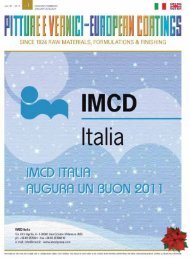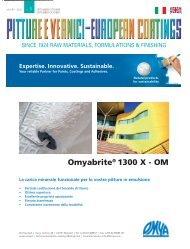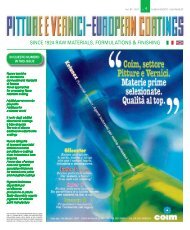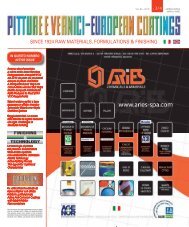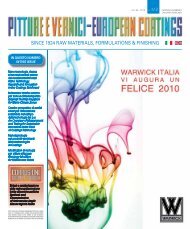MATERIE PRIME PER EDILIZIADegrado estetico e funzionale della facciata di un edificioAesthetic and functional degradation of a building facadeca positiva, polarizzano i gruppi organici(R) ad essi legati così da renderli menosuscettibili di essere ossidati.Oltre alla loro eccellente resistenzaalla luce ultravioletta, al calore, all’ossidazionee corrosione, i polisilossanihanno altre singolari caratteristicheche li rendono di estremo interessecome co-leganti per idropitture:- Bassa tensione superficiale che permetteuna buona bagnabilità e adesioneal supporto- Ridotto assorbimento d’acqua graziealla disposizione dei gruppi organici polarisulla superficie del film- Permeabilità al vapore acqueo- Buona flessibilità che consente di compensareadeguatamente le sollecitazionidel supporto e le dilatazioni termiche.Struttura della catena silossanicaSiloxane chain structureLa teoria di Künzele le pitture silossanicheQuesta teoria, rimane il riferimentoper ogni tipo di ricerca formulativa suimateriali per la protezione e decorazionedi facciate. Due sono le proprietà delrivestimento che influenzano maggiormentele caratteristiche di protezione etraspirabilità: la capacità d’assorbimentod’acqua e la permeabilità al vapore.Un materiale da costruzione nonsubisce danni nel tempo, se la sua capacitàdi cedere acqua è maggiore dellasua capacità di assorbimento per capillarità.È possibile formulare particolaripitture e rivestimenti decorativicon caratteristiche strutturali e chimico-fisichetali per cui essi non trattengonol’umidità all’interno della muraturache è causa principale dei deterioramentie di gran parte delle patologie dellefacciate.La capacità di cedere acqua si esprimecome permeabilità al vapore (ovverocome resistenza alla sua diffusione), inpratica può essere assimilata allo spessore(in m lineari) dello strato d’ariae<strong>qui</strong>valente Sd avente la medesima resistenzaalla diffusione al vapore del rivestimento.In generale, tale valoredipende direttamente dal valore PVC(Pigment Volume Concentration) è puòvariare da 0,1 m (nel caso delle pittureai silicati) fino a 2 m per pitture con bassissimaporosità (acriliche a solvente).Il coefficiente di assorbimento d'acquaw rappresenta invece una misura dell’assorbimentocapillare d’acqua di unrivestimento o materiale da costruzione.Per un sistema efficace di protezionedelle facciate, il valore Sd ed il valore wdevono essere minimizzati: solo in questomodo si riesce a conferire elevatadiffusione al vapore e basso assorbimentod’acqua.Sistemi con tali caratteristiche, perdonopiù acqua quando asciugano diquella che sono in grado di assorbirequando vengono bagnati (ad es. dallapioggia battente). I formulati contenentico-leganti siliconici in opportuna percentualee/o additivi idrofobizzantimassimizzano la traspirabilità e l’idrorepellenza.Le pitture ai silossani <strong>qui</strong>ndisono caratterizzate da un’elevata porositàcapillare che permette un’altrettantoelevata traspirabilità al vapore(basso valore Sd). Nella maggioranza deicasi tale porosità viene raggiunta mantenendoil valore di PVC al di sopra diuna determinata soglia critica (CPVC) laquale può essere variata mediante opportunascelta dei pigmenti, delle carichee della tipologia del legante. L’elevataporosità capillare, però, causerebbeun aumento dell’assorbimento d’acquase tali prodotti non fossero altamenteidrofobici: i particolari gruppi organicilegati all’atomo di silicio della catenaprincipale conferiscono questocarattere e la loro natura chimica influenzadirettamente il valore dell’angolodi contatto della pittura asciutta(> 140° circa, è sinonimo di elevata idro-Diffusione al vapore d’acqua - EN ISO 7783-2Water Vapour Diffusion - EN ISO 7783-2Classe Diffusione / Diffusion Sd [m] / Sd(m)I alto / High < 0,14II medio / Medium 0,14-1,40III basso / Low > 1,40Coefficiente di assorbimento d’acqua w - EN 1062-3Coefficient of Water Absorption w - EN 1062-3Classe Assorbimento / Absorption w [kg/(m 2·√24h)]I alto / High > 0,5II medio / Medium 0,1-0,5III basso / Low < 0,1RAW MATERIALS FOR BUILDING SECTOROnly the products based on siloxane resinsand additives can combine effectively thetranspiration and the water repellencyproperties. Such products stand for thestate of the art of the waterborne paints forexterior: besides an organic binder (usuallyan acrylic or styrene-acrylic one), as amatter of fact, they contain emulsion siliconeresins and low amounts of specialorgano-modified siloxanes, increasing theirhydrophobic effect.Since the siloxane polymers are widely inorganic(the main chain is Si-O) are intrinsicallymore resistant to the oxidationprocess than the polymers of the carbonchemistry: the disbonding energy of the silicon-oxygenbond is equal to 108 kcal/mole,that is much higher than the polymer C-Cbond belonging to the traditional organiccoatings (83 kca/mole).The highest amount of energy re<strong>qui</strong>red tobreak the Si-O bond provides a greater resistanceto the atmospheric agents and to10Pitture e Vernici - European Coatings • 10 / 2010the thermal degradation. Furthermore, theorganic replacing agents which are bondedto the silicon atom protect the Si-O-Rbonds from hydrolysis through the sterichindrance; at the same time, the siliconatoms with an electronic positive charge,polarize the organic groups (R) which arebonded to them, so as to make them lessprone to the oxidation process.The polysiloxanes not only show an excellentUV, heat, oxidation and corrosion resistance,but they are provided with otherspecial characteristics which make them reallyinteresting as co-binders for waterbornepaints:- low surface tension for good wetting propertiesand adhesion on the substrate- low water absorption due to the organicgroup localization on the film surface- water vapour permeability- good flexibility allowing to compensateproperly for the substrate stresses andthermal expansion.Künzel theoryand siloxane paintsThis theory is still the benchmark for anytype of formulation search about materials,in view of the protection and of the decorationof the façades. There are twocoating properties most affecting the protectionand transpiration properties: thewater absorption capability and the vapourpermeability. A construction material doesnot get damaged over time if its water releaserate is higher than its absorption rateby capillarity. It is possibile to formulatespecial paints and decorative coatings providedwith structural and chemical-physicalcharacteristics, so that they do notretain the moisture within the wall, whichis the most important cause of deteriorationand of most facade “diseases”.The water release capability is referred toas vapour permeability (that is as its diffusionresistance); generally speaking itcan be strictly related to the thickness (linearm) of the e<strong>qui</strong>valent Sd air layer, showingthe same vapour diffusion resistanceas the coating. In general, such a ratedipends directly on the PVC rate (PigmentVolume Concentration) and it can rangefrom 0,1 m (in the case of silicate basedpaints) up to 2 m for very low porous paints(solvent based acrylic paints). Conversely,the water absorption coefficient w standfor the water capillary absorption measurementof a coating or a construction material.In a high-performance protectionsystem for façades, the Sd and w valuesshould be minimized: only in this way it ispossibile to provide a high vapour diffusionand low water absorption rates. Thesystems endowed with such characteristicslose more water when they get dry,compared with the water which they canabsorb when they get wet (for example bya beating rain).The formulations containing the proper sil-▼▼
MATERIE PRIME PER EDILIZIAPitture Pitture ai Pitturein emulsione silicati silossanicheEmulsion Silicate Siloxanebased paints based paints based paintsSuperficie Film chiuso Porosa PorosaSurface Closed film Porous PorousProtezione Ottima Bassa Ottimadall’acquaProtection Excellent Low ExcellentAgainst waterTraspirabilità Bassa Molto elevata Molto elevataTranspiration Low Very high Very highrepellenza). Infatti, gli atomi di ossigenodella catena principale si orientanoverso il substrato mentre i gruppi organicilegati al silicio verso l’esterno dellasuperficie della pittura. La densità ela natura dei sostituenti organici che sidispongono nello strato più esternodella superficie, sono direttamente responsabilidell’angolo di contatto delfilm asciutto. I prodotti silossanici appartengono<strong>qui</strong>ndi ai più avanzati sistemidi rivestimento per facciate e offrononotevoli vantaggi sia su strutturenuove sia nelle opere di risanamentoe ristrutturazione. Non da ultimo, posseggonoanche pregi estetici tra cuiun’ampia gamma cromatica con colorivivaci e una finitura opaca che li rendeparticolarmente indicati anche per la decorazionedi edifici d’interesse storico.Le pitture ai silossani infine, grazie all’elevatoangolo di contatto, ogni voltache piove fanno sì che le particelle disporco depositate vengano dilavatedall’acqua piovana. La facciata rimane<strong>qui</strong>ndi pulita più a lungo e il supportoperfettamente asciutto. Tale fenomenoè tanto più accentuato quanto più la superficiesi presenta liscia e priva di difetti.In conclusione, si può affermareche i prodotti silossanici combinano almeglio i benefici dei rivestimenti mineralicon quelli dei sistemi polimerici.Variphob SR:resine silossanichein emulsione acquosaLa linea Variphob SR comprende macroemulsioniesenti da solvente, a bassocontenuto di composti organici volatili(“low VOC”) che vengono impiegatecome co-leganti nella formulazione dipitture silossaniche e rivestimenti sinteticiper esterni. Tutti i prodotti CHThanno un ridottissimo contenuto dispeciali emulsionanti (parte idrofila delsistema) che contribuisce a massimizzareil loro carattere idrofobico.Le facciate rivestite con pitture a basedi resine Variphob SR si mantengonoasciutte più a lungo aumentando così laprotezione contro funghi, microalghe edefflorescenze saline. Grazie alla loro particolarestruttura chimica, le resine VariphobSR aumentano significativamenteil ciclo di vita delle facciate. Inmedia, un rivestimento a film sottile contenentesolamente polimeri di natura organicaconsente di salvaguardarel’aspetto e l’integrità delle facciate percirca una decina d’anni. Tale periodo siriduce anche sensibilmente in zone climatichecon elevato tasso d’umidità atmosfericae/o con un livello medio diprecipitazioni elevato. Le resine co-legantiVariphob SR permettono di prolungareil periodo medio di vita del rivestimentoriducendo al minimo la necessitàdi interventi di ristrutturazionee risanamento e <strong>qui</strong>ndi anche i costi dimanutenzione. È facile comprendere cheil miglior sistema di protezione delle facciatenon è quello più a buon mercatobensì quello che nel lungo periodoconsente di proteggere al meglio ilsupporto conservando il più possibileinalterato l’aspetto estetico. Le resinesiliconiche riescono a legare stabilmenteal loro interno i pigmenti garantendoottima resistenza agli agenti atmosfericied elevata resistenza ai raggiUV. In questo modo mantengono inalteratonel tempo il cromatismo originario dellapittura.Gli additivi silossaniciamminofunzionaliVariphob HPPittura senza Variphob HP 105Variphob HP 105 free paintPittura con Variphob HP 105Variphob HP 105 based paintLe facciate si sporcano perché le particellecontaminanti vengono attratteelettrostaticamente dal film di pitturapolimerica e si fissano in maniera stabilenella morfologia superficiale a seguitodell’azione degli agenti atmosferici.CHT propone un’ampia gamma diadditivi silossanici che grazie alle lorospeciali proprietà consentono di ridurredrasticamente tale fenomeno.Le emulsioni Variphob HP hp sono ammino-silossanicon differenti modificheorganiche, che impediscono l’attrazioneelettrostatica di polvere e sporcizia.Impiegati come additivi “perlanti” sia inidropitture silossaniche sia nelle tradizionalipitture acriliche per esterno aumentanol’angolo di contatto, la traspirabilitàdel rivestimento riducendoallo stesso tempo la presa di sporco. Gliadditivi Variphob HP offrono i massimistandard in termini di prestazioni, duratae facilità di impiego. Compatibili con tuttii sistemi a base acqua, hanno un’elevatastabilità allo stoccaggio e non per-RAW MATERIALS FOR BUILDING SECTOR▼▼icone co-binders and/or hydrophobic promotersagents content rate maximize thetranspiration and the water repellencyproperty. Therefore, the siloxane basedpaints show a high capillare porosity whichallows as well a high vapour transpiration(low Sd value). In most cases, such a porosityis reached keeping the PVC value abovea given critical threshold (CPVC), which canbe varied through the adequate selectionof pigments, extenders and of the type ofbinder. Nevertheless, the high capillaryporosity would cause an increase in thewater absorption if such products were nothighly hydrophobic: the particular organicgroups bonded to the silicon atom in themain chain provide this effect and theirchemical nature directly affects the drypaint contact angle value (around > 140°,means high water repellancy). In fact, theoxygen atoms of the main chain lead theway to the substrate while the organicgroups which are bonded to silicon, are orientedto the external part of the paint surface.The density and the nature of the organicreplacing agents, which are localizedon the most external layer are directly responsiblefor the dry film contact angle.The siloxane based products belong to themost advanced coating systems forfaçades and they provide huge benefitsboth to new structures and to the restorationand restructuring operations. Last butnot least, they also show great aestheticqualities including a wide range of brightcolours and an opaque finish which makesthem ideal also for the decoration of historicalbuildings. Finally, the siloxane basedpaints, due to their high contact angle, allthe time it’s raining, role a play since theycause the dirty particle washing, as theysettle down. So, the facade keeps cleanfor a longer time and the substrate keepsperfectly dry. The more frequently this phenomenonhappens, the smoother and flawfree the surface.Finally, it can be stated that the siloxanebased products combine at best the benefitsoffered by the mineral coatings andthe polymer based ones.Variphob SR: the wateremulsion siloxane resinsThe Variphob SR line of products includessolvent free and low VOC macroemulsions,which are used as co-binders in the formulationof siloxane paints and syntheticcoatings for exteriors. All products by CHThave a very low special emulsifying agentcontent rate (the hydrophilic part of the system)contributing to maximize their hydrophobicnature. The façades which arecoated with the Variphob SR resin basedpaints keep dry for a longer time thus increasingthe protection performance a-gainst fungi, microseeds and salt efflorescence.Due to their special chemicalstructure, the Variphob SR resins sensiblylengthen the façades life cycle.On average, a thin film coating based onlyon organic polymers allows to protect theaesthetic properties and the integrity of thestructure for about ten years. Such a periodalso decreases in those climatic zones witha high humidity rate and/or with a high averagerain occurrences rate.The Variphob SR co-binder resins allow tolengthen the average service life of the coatingminimizing the restructuring and restoringinterventions, and, therfore, the maintenancecosts. It is easy to understand thatthe best protection system for façades is notthe cheapest one, but the one which in thelong term allows to protect at best the substratekeeping as much as possible its originalappearance. The Variphob SR siliconeresins manage to bond efficaciously the pigmentsthus guaranteeing excellent weatheragents and UV resistance. Thus, they protectthe original paint colour over time.Pitture e Vernici - European Coatings • 10 / 201011



